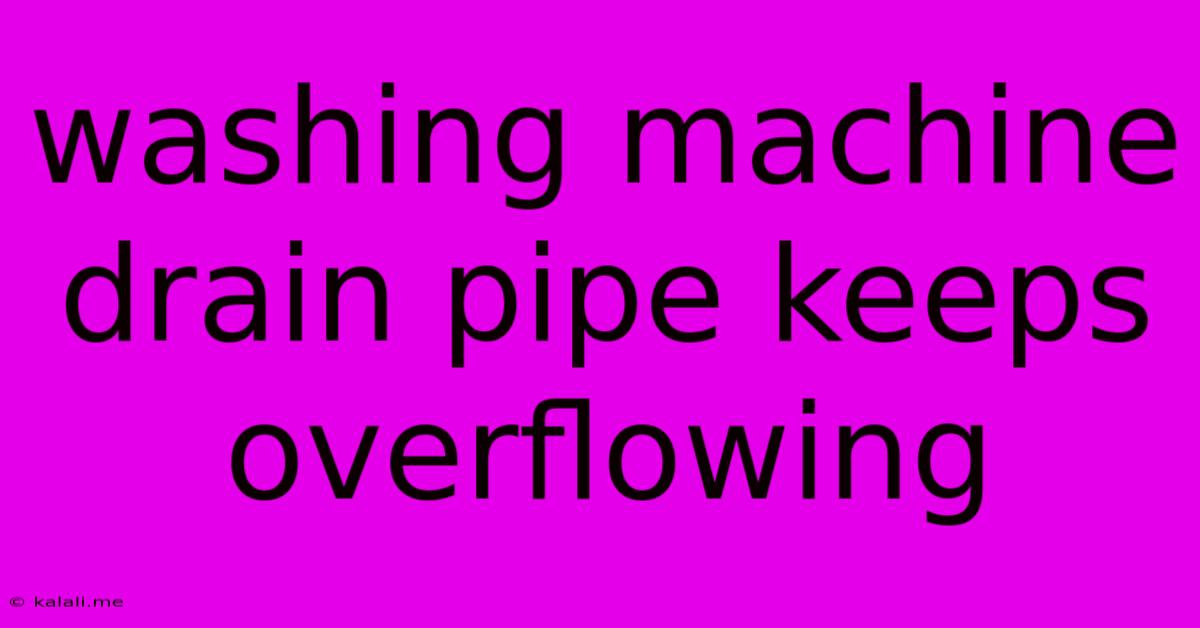Washing Machine Drain Pipe Keeps Overflowing
Kalali
Jun 05, 2025 · 3 min read

Table of Contents
Washing Machine Drain Pipe Keeps Overflowing: Troubleshooting and Solutions
Meta Description: Is your washing machine drain pipe constantly overflowing? This guide diagnoses common causes – from clogged pipes to faulty pumps – and offers practical, step-by-step solutions to get your laundry back on track.
A overflowing washing machine drain pipe is a frustrating plumbing problem. It’s messy, inconvenient, and can signal a more significant issue with your washing machine or plumbing system. Before calling a costly plumber, let's troubleshoot the problem and explore potential solutions. This guide will walk you through common causes and provide practical steps to fix the issue yourself.
Common Causes of an Overflowing Washing Machine Drain Pipe
Several factors can contribute to a washing machine drain pipe overflowing. Identifying the root cause is crucial for effective repair. The most frequent culprits include:
-
Clogged Drain Pipe: This is the most common cause. Hair, lint, soap scum, and other debris can build up over time, restricting water flow and causing a backup. The clog might be in the drain pipe leading from the washing machine, within the standpipe, or even further down the main drain line.
-
Blocked Standpipe: The standpipe is the vertical pipe connected to your washing machine drain hose. A blockage here prevents proper drainage and leads to overflow.
-
Kinked or Restricted Drain Hose: A kink or crimp in the washing machine's drain hose restricts water flow, resulting in slow drainage and overflow. Ensure the hose isn't crushed or twisted.
-
Faulty Washing Machine Pump: A malfunctioning pump within the washing machine itself might not be effectively pumping water out, leading to overflow. This is less common but requires more serious attention.
-
Improper Drain Hose Installation: If the drain hose isn't installed correctly (e.g., too high, improperly secured), it can lead to drainage issues. The drain hose should be positioned properly to ensure a gravity-assisted flow.
-
Low Water Pressure: While less likely to directly cause an overflow, very low water pressure can make it harder for the pump to drain the water effectively, contributing to a slower drain and potential overflow.
Troubleshooting Steps: Identifying the Culprit
Let's systematically troubleshoot the issue:
-
Check the Drain Hose: Inspect the drain hose for kinks, bends, or blockages. Straighten any kinks and ensure the hose is free from obstructions.
-
Inspect the Standpipe: Carefully examine the standpipe for any visible clogs or blockages. Use a plumber's snake or a bent wire hanger to carefully remove any obstructions.
-
Check the Drain Pipe: Use a drain snake or auger to clear any blockages in the drain pipe leading from the washing machine. This may require access under the sink or to other parts of the plumbing system. Work slowly and carefully to avoid damaging the pipes.
-
Run a Drain Cleaning Solution: Pour a commercial drain cleaner (following product instructions carefully) down the drain to dissolve any remaining clogs. Allow ample time for the cleaner to work its magic before attempting to drain water again.
-
Check the Washing Machine Pump (Advanced): This step requires some technical knowledge and might involve disassembling parts of your washing machine. Consult your washing machine's manual or seek professional assistance if you're unsure how to access and inspect the pump.
Preventing Future Overflow Problems
Prevention is key! Here are some proactive steps:
-
Regular Cleaning: Regularly clean the washing machine's lint filter and use a drain cleaner periodically to prevent clogs.
-
Proper Hose Placement: Ensure the drain hose is correctly installed and secured, avoiding kinks or bends. Position it at the appropriate height according to your washing machine's instructions.
-
Avoid Overloading: Avoid overloading the washing machine, as this can strain the pump and lead to drainage issues.
-
Regular Maintenance: Conduct regular maintenance checks on your washing machine and plumbing system.
By following these troubleshooting steps and preventative measures, you can effectively address the overflowing washing machine drain pipe issue and avoid costly repairs. If the problem persists after attempting these solutions, it's advisable to consult a qualified plumber.
Latest Posts
Latest Posts
-
How Many Rings Until Missed Call Iphone
Jun 07, 2025
-
The Certificate Chain Was Issued By An Authority
Jun 07, 2025
-
Cifs Filesystem Not Supported By The System
Jun 07, 2025
-
Instructions For The Board Game Sorry
Jun 07, 2025
-
Can You Start Sentence With As
Jun 07, 2025
Related Post
Thank you for visiting our website which covers about Washing Machine Drain Pipe Keeps Overflowing . We hope the information provided has been useful to you. Feel free to contact us if you have any questions or need further assistance. See you next time and don't miss to bookmark.